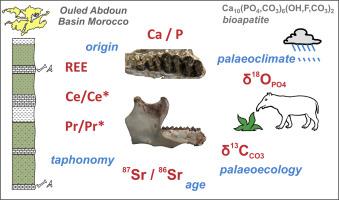Palaeogeography, Palaeoclimatology, Palaeoecology ( IF 2.6 ) Pub Date : 2021-06-07 , DOI: 10.1016/j.palaeo.2021.110523 László Kocsis , Alex Ulianov , Mustapha Mouflih , Fatima Khaldoune , Emmanuel Gheerbrant

|
We performed different geochemical analyses of Paleogene terrestrial mammal remains to establish their taphonomy, stratigraphic provenance, and palaeoenvironmental conditions. Rare earth element (REE) results indicate a similar diagenetic history to that of previously investigated marine taxa from these beds. Therefore, the mammal remains were initially deposited in a marine setting, and probably not long after the death of the animals their bodies were washed into the sea. The Ce/Ce* and Pr/Pr* ratios for the mammal fossils were compared with the background dataset from the phosphate mines, which varies with time. This allowed us to characterize the stratigraphic levels bearing the fossils. The provenances of fossils with known origins were confirmed, while remains with unknown origins could be assigned to certain stratigraphic horizons that are compatible with previously proposed phylogenic relationships.
Marine diagenesis affected the various skeletal tissues differently, with the largest alteration in the bone and the least or none in the enamel. This is mostly demonstrated by the high F concentration, high Ca/P, and seawater related 87Sr/86Sr in the bone/dentine samples. Enamel shows the opposite, and retained the most pristine terrestrial values. The δ18OPO4 and δ13C results from mammal enamel revealed warm (>20 °C mean annual temperature-MAT) and dry (<500 mm mean annual precipitation) conditions for Paleocene-Eocene period in the region. From the early to mid-Ypresian about +5 °C ΔMAT is recorded that might be linked to the Early Eocene Climatic Optimum.
Furthermore, the 87Sr/86Sr ratios derived from shark tooth enameloid fit the global open ocean Sr-isotope record during the latest Paleocene and early Eocene providing further evidence for the age of these phosphate beds in the Ouled Abdoun Basin. However, older marine fossils yielded higher ratios than the global Sr-isotope curve, reflecting an alteration and/or somewhat restricted conditions in the Moroccan coastal basins, possibly triggered by global sea-level changes.
中文翻译:

Ouled Abdoun 盆地(摩洛哥古新世-始新世)哺乳动物的埋藏学、地层学和古生态学的地球化学调查
我们对古近纪陆生哺乳动物遗骸进行了不同的地球化学分析,以确定它们的埋藏学、地层来源和古环境条件。稀土元素 (REE) 结果表明,与先前研究的来自这些床的海洋分类群具有相似的成岩历史。因此,哺乳动物的遗骸最初存放在海洋环境中,可能在动物死亡后不久,它们的尸体被冲入海中。将哺乳动物化石的 Ce/Ce* 和 Pr/Pr* 比率与磷矿的背景数据集进行比较,后者随时间而变化。这使我们能够表征带有化石的地层水平。确认了已知来源化石的来源,
海洋成岩作用对各种骨骼组织的影响不同,骨骼中的变化最大,牙釉质中的变化最小或没有。这主要通过骨/牙本质样品中的高 F 浓度、高 Ca/P 和与海水相关的87 Sr/ 86 Sr 来证明。珐琅显示出相反的情况,并保留了最原始的陆地价值。来自哺乳动物牙釉质的 δ 18 O PO4和 δ 13 C 结果显示该地区古新世-始新世时期温暖(> 20 °C 平均年温度-MAT)和干燥(<500 毫米年平均降水量)条件。从伊普雷西亚早期到中期,记录了大约 +5 °C 的 ΔMAT,这可能与早始新世气候最适有关。
此外,来自鲨鱼牙釉质的87 Sr/ 86 Sr 比率符合最新古新世和始新世早期全球公海 Sr 同位素记录,为 Ouled Abdoun 盆地这些磷酸盐层的年龄提供了进一步的证据。然而,较旧的海洋化石产生的比率高于全球 Sr 同位素曲线,反映了摩洛哥沿海盆地的改变和/或有些限制条件,可能是由全球海平面变化引发的。











































 京公网安备 11010802027423号
京公网安备 11010802027423号